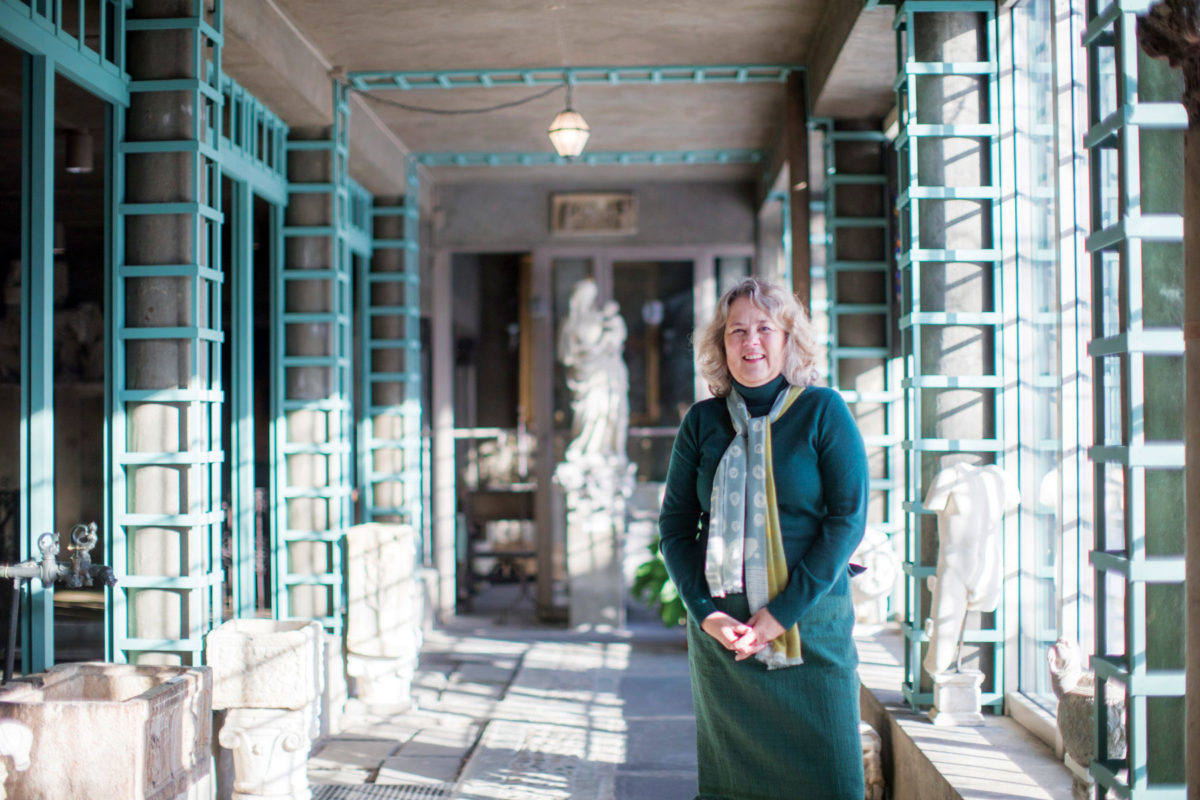Telling Past Lives, Tracing Cultural Effects
Natalie Dykstra, Ph.D. | Professor of English
In 2016, when Boston magazine ranked the “100 Best Bostonians of All Time,” Isabella Stewart Gardner came in fourth — just behind John F. Kennedy and right before Malcolm X. The wealthy, influential Gardner (1840–1924), whose eponymous art museum is a Boston must-see, transformed the city’s cultural landscape more than a century ago by being, as the magazine described her, a “patron of the arts, maverick, feminist.”
Dr. Natalie Dykstra spent 2019 in Boston immersed in research and writing for her biography of Gardner, which Houghton Mifflin Harcourt is to publish in 2023. Gardner created an opulent, groundbreaking, world-class art museum which opened in 1903 to be, in perpetuity, “for the education and enjoyment of the public.” In her will she directed that none of its contents could ever be rearranged after her death. She stood shoulder-to-shoulder with her husband, the businessman and philanthropist John Lowell Gardner Jr., and with revered figures of her day including novelist Henry James, historian Henry Adams and painter John Singer Sargent. Her strong vision, opinions and work ethic catapulted her to a place of social and cultural curiosity and acclaim. Even so, Dykstra says, “though Isabella’s legacy is feminist, it is misreading her to imagine her as a feminist in the way that we understand that word today. She did not join suffragette causes or social action committees for equal pay. Instead, she tried to change her world through the arts and gave quietly to other causes that protected the most vulnerable in society: children and animals.”
In collecting for and establishing her four-story museum, called Fenway Court in her day — a pursuit that lasted decades and took her on months-long trips to Europe and Asia to do her collecting — Gardner was a sometimes boisterous and always determined force to be reckoned with in a male-dominated art world.
She was the first collector to bring paintings by Vermeer and Botticelli to the United States.
She outmaneuvered collectors with deeper pockets to purchase masterpieces by Titian, Raphael and Rembrandt.
She was the first to design and erect a museum building specifically for a personal collection.
She did so by being, in Dykstra’s words, “a savvy entrepreneur” and “incredibly smart.” She lived life on her own terms, no matter the cultural currents for women at the time.
“Isabella somehow was able to resist the messages, spoken and unspoken, to not do what she was doing,” Dykstra explains. “Sometimes I think people say, ‘Well, she was wealthy, so she could do what she wanted,’ but that’s not entirely the case. She was taking risks in doing what she was doing. She was stepping out of a prescribed role for women. And actually, those prescriptions for how to behave sometimes intensify with wealth. They become more elaborate. So, I think she was very, very brave to follow something inside herself that was very powerful, even though that’s more 21st-century language than she would have used.”
Much of Dykstra’s research takes place at the Gardner Museum Archives, the Massachusetts Historical Society and the Houghton Library at Harvard University. She also has retraced Gardner’s footsteps through Paris, Venice and Florence, and met on a private island off the coast of Maine with descendants of the Gardner family to unearth new insights about her subject’s life. With each journey and conversation, Dykstra becomes more and more impressed by Gardner’s through-line from early loss (her only child, a son, died at the age of 20 months) to triumph. “She had an extraordinary life, with great sorrow, too, but somehow that sorrow did not unmoor her. Her capacity to enjoy life and her response to beauty is what’s so memorable about her, and is why I’m drawn to her story,” Dykstra says.
As are over 300,000 visitors to the Gardner Museum annually. A younger generation is attracted to the maverick, “who was unapologetic about what she was doing,” Dykstra says. “The museum is popular with millennials. It’s packed on Thursday nights, when it’s open late. It’s like Thursday date night in Boston. I think young women and men adore it. I think they think she’s cool and strong and glamorous and distinctive. And I think they understand her entrepreneurial spirit and the risks that she took.”
This is Dykstra’s second biography of an elite Boston woman. Her first, the Massachusetts Book Award finalist Clover Adams: A Gilded and Heartbreaking Life (Houghton Mifflin Harcourt, 2012), tells the story of a photographer who struggled to find her way and met a tragic end when she took her own life at the age of 42. Gardner’s story is just the opposite for its subject’s longevity and assuredness. While writing Clover Adams, Dykstra earned a National Endowment for the Humanities Year-Long Fellowship; in 2019 she received another year-long NEH fellowship, this time a Public Scholar Award, for her work on the Gardner biography.
“The book about Clover was a kind of chamber piece,” Dykstra reflects. “It was a ghost story, very intimate and in a constrained time frame. Isabella lived twice as long as Clover. And the way she lived makes her story like a full-on orchestra backed up by many choirs.”
View images and learn more about the Isabella Stewart Gardner Museum at gardnermuseum.org — and visit nataliedykstra.com for more on Dr. Dykstra’s upcoming book.

